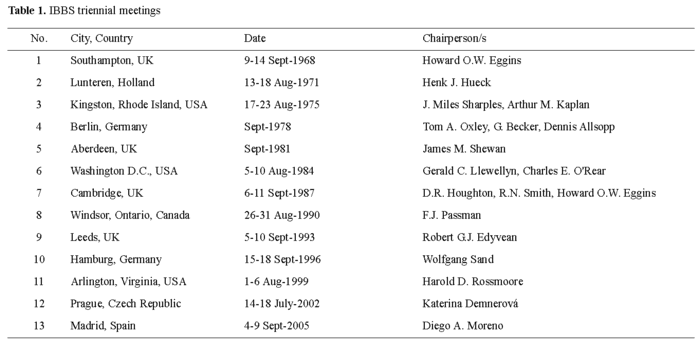Meu SciELO
Serviços Personalizados
Journal
Artigo
Indicadores
-
 Citado por SciELO
Citado por SciELO -
 Acessos
Acessos
Links relacionados
-
 Citado por Google
Citado por Google -
 Similares em
SciELO
Similares em
SciELO -
 Similares em Google
Similares em Google
Compartilhar
International Microbiology
versão impressa ISSN 1139-6709
INT. MICROBIOL. vol.8 no.3 Set. 2005
| EDITORIAL | |||
|
| |||
| The 13th International Biodeterioration and Biodegradation Symposium | ||
| |||
The 2005 September issue of International Microbiology is a monograph comprising major contributions to the 13th International Biodeterioration and Biodegradation Symposium (IBBS-13, Madrid, 4-9 September 2005). Since 1968, when the first International Biodeterioration Symposium was held in Southampton, UK, to the IBBS-12, held in Prague, Czech Republic, in 2002, which was brilliantly organized by Katerina Demnerova, several thousand researchers have presented contributions covering a wide variety of topics to the Symposia.
The aim of the IBBS is to provide a framework that allows researchers to meet and discuss trends and achievements in biodeterioration and biodegradation. At the first symposia, contributions focused mostly on industrial studies of biodeterioration and biodegradation of different materials. In the most recent symposia, greater attention has been devoted to bioremediation of the environment, as well as to the biodeterioration of artworks and objects of historical and cultural importance. The techniques and approaches for these kinds of studies have evolved, as evidenced by the fact that, currently, most of the studies include molecular microbiological tools developed in the early 1990s.
When James T. Walker, past president of the International Biodeterioration & Biodegradation Society (IBBS), asked me, in July 2003, to organize IBBS-13, I was fully aware of the tremendous responsibility, effort, and dedication that such a task would require. At the same time, I was proud to accept the position, as it was the first time the Symposium would be held in Spain. In 2005, the year Spain is celebrating the 400th anniversary of the book Don Quixote. Another man from La Mancha-I am indeed from La Mancha (Ledaña, Cuenca)-was called upon to fight the windmills and brave the unparalleled adventures that are inevitably encountered in administering an international conference of this scope. In contrast to Don Quixote, however, I was not alone. Instead, I was able to count on the help of both the Biodeterioration and Biodegradation Specialized Group of the Spanish Society for Microbiology (SEM), of which I am co-founder and current vice-president, and the Biodeterioration Group that I lead at the Technical University of Madrid. Don Quixote believed that the balsam of Fierabrás (Don Quixote´s cure-all potion) was the remedy that would allow him to win any kind of battle or combat. For the organization of the IBBS-13, I have also had my own balsam of Fierabrás, in the form of Carlos Ranninger and Fernando Laborda. Ranninger has extensive experience in organizing national and international conferences, and Laborda is the former president of the IBBS.
As this editorial is being written, the number of pre-registrations for IBBS-13 is about 304, from 52 countries from around the world. This confirms the trend of the IBBS-12 in Prague, attended by 310 people from 43 countries. Until IBBS-12, the number of participants was between 150 and 200, from about 20 countries. The increase in the number of countries represented in the IBBS (Table 1) confirms the growing worldwide recognition of the importance of the studies on biodeterioration and biodegradation.
The IBBS-13 is dedicated to Harold W. Rossmoore, founder of the International Biodeterioration & Biodegradation Society and also its president. In 1997, he was named Honorary Member of the Spanish Society for Microbiology, upon the request of the SEM Biodeterioration and Biodegradation Specialized Group. For this reason, this issue begins with Harold’s obituary, written by his friend, Fernando Laborda.
Since the IBBS-13 is being held in Spain, it seemed appropriate to include a large number of Spanish speakers of international prestige. If we added up all the years of research carried out by all the invited speakers and their published work, we would have more than 250 years of experience and more than 500 publications in SCI journals related to biodeterioration and biodegradation, which is a considerable feat in itself. This monograph presents some of the current topics in this young subfield of microbiology.















